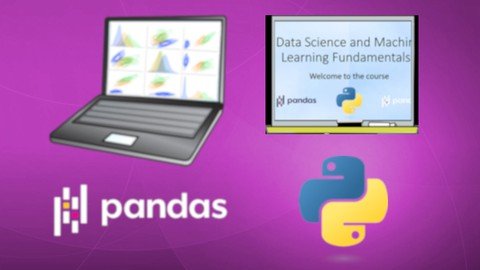
Published 5/2023
MP4 | Video: h264, 1280×720 | Audio: AAC, 44.1 KHz
Language: English | Size: 5.54 GB | Duration: 12h 18m
Data Science and Machine Learning Fundamentals with Python and Pandas
Data Science and Machine Learning Fundamentals with Python and Pandas
What you’ll learn
Knowledge about Data Science and Machine Learning theory, algorithms, methods, best practices, and tasks
Deep hands-on knowledge about Data Science and Machine Learning, and know how to do common Data Science and Machine Learning tasks
The ability to handle and execute common Data Science and Machine Learning tasks with confidence
Basic Python and Pandas for data handling, and knowledge about Scikit-learn, Statsmodels, Matplotlib, Seaborn, and other libraries
Detailed knowledge about Regression Prediction, Classification, and Cluster analysis
Requirements
The sole requirements are the four ways of counting (+-*/) and everyday experience with Windows, or Linux, or Mac-OS.
Description
This course is an exciting hands-on view of the fundamentals of Data Science and Machine LearningData Science and Machine Learning are developing on a massive scale. Everywhere you look in society, the world wide web, or in technology, you will find Data Science and Machine Learning algorithms working behind the scenes to analyze and optimize all aspects of our lives, businesses, and our society.Data Science and Machine Learning with Artificial Intelligence are some of the fastest-developing areas right now. This course will teach you the fundamentals of Data Science and Machine Learning, and has content that will teach you many new things regardless of if you are a beginner or an experienced Data Scientist.You will learn aboutRegression and Prediction with Machine Learning models using supervised learning. This course has one of the most complete and fundamental content packages on Udemy, with hands-on, useful practical theory, and automatic Machine Learning algorithms for model building and feature selection, and artificial intelligence. You will learn about models ranging from simple linear regression models to more advanced multivariate polynomial regression models.Classification with Machine Learning models using supervised learning. You will learn about the classification process, classification theory, and visualizations as well as some useful classifier models.Cluster Analysis with Machine Learning models using unsupervised learning. In this part of the course, you will learn about unsupervised learning, cluster theory, artificial intelligence, explorative data analysis, and 7 useful Machine Learning cluster algorithms. The fundamentals of Data Science and Machine Learning.Basic Python and Pandas for data handling.This course includesa comprehensive and easy-to-follow teaching package for basic Python and Pandas for data handling, which makes anyone able to learn the course contents regardless of beforehand knowledge of programming, tabulation software, Python, Data Science, or Machine Learning.an easy-to-follow guide for downloading, installing, and setting up the Anaconda Distribution, which makes anyone able to install the Python Data Science and Machine Learning environment for this course.content that will teach you many new things, regardless of if you are a beginner or an experienced Data Scientist.a large collection of unique content, and will teach you many new things that only can be learned from this course on Udemy.A course structure built on a proven and professional framework for learning.A compact course structure and no killing time.Is this course for you?This course is for you, regardless if you are a beginner or an experienced Data Scientist. This course is for you, regardless if you have a Ph.D. or no education or experience at all.Course requirementsThe four ways of counting (+-*/)Basic everyday experience with either Windows, Linux, Mac OS, or similar operating systemsAfter completing this course, you will haveKnowledge about Data Science and Machine Learning theory, algorithms, methods, best practices, and tasks.Deep hands-on knowledge of Data Science and Machine Learning, and know how to do common Data Science and Machine Learning tasks.The ability to handle and execute common Data Science and Machine Learning tasks with confidence.Basic Python and Pandas for data handling, and have knowledge about Scikit-learn, Statsmodels, Matplotlib, Seaborn, and other libraries.Detailed knowledge about Regression Prediction, Classification, and Cluster Analysis.
Overview
Section 1: Introduction
Lecture 1 Course introduction
Lecture 2 Download and installation of the Anaconda Distribution plus Visual Studio Code
Lecture 3 Setup of Anaconda Distribution for this course
Section 2: Basic Python and Pandas for data handling
Lecture 4 Overview plus integers, floats, and strings
Lecture 5 Set, Tuple, Dictionary, and Lists
Lecture 6 Data Transformers and Functions
Lecture 7 Introduction to Pandas, the DataFrame
Lecture 8 Pandas, loading and saving files
Lecture 9 Pandas operations and techniques. Select, Extract, and Slice
Lecture 10 Pandas: Data cleaning, preparation, description, and visualization
Section 3: Regression and Prediction with Machine Learning models
Lecture 11 Regression and Supervised Learning. Overview, and assumptions to diagnostics
Lecture 12 Regression and Prediction, some practical modelling concepts
Lecture 13 Linear Multiple Regression model. Model building and automatic forward selection
Lecture 14 Multivariate Polynomial Regression models and automatic feature selection
Lecture 15 Regression Regularization, Lasso and Ridge models
Lecture 16 Decision Tree Regression models
Lecture 17 Random Forest Regression
Section 4: Classification with Machine Learning models
Lecture 18 Classification, overview, the classification process, and theory
Lecture 19 Logistic Regression for Classification
Lecture 20 The Naive Bayes Classifier
Lecture 21 The Decision Tree Classifier and visualizations of Tree Classifiers
Lecture 22 The Random Forest Classifier
Section 5: Cluster Analysis and Unsupervised Learning with Machine Learning models
Lecture 23 Cluster Analysis, overview and pedagogy
Lecture 24 K-Means Cluster Analysis, and an introduction to auto-updated K-means algorithms
Lecture 25 Density-Based Spatial Clustering of Applications with Noise (DBSCAN)
Lecture 26 Four Hierarchical Clustering algorithms
Section 6: Advanced Machine Learning models and tasks
Lecture 27 Overview
Lecture 28 Artificial Neural Networks, Feedforward Networks, and the Multi-Layer Perceptron
Lecture 29 Feedforward Multi-Layer Perceptrons for Classification tasks
Lecture 30 Feedforward Multi-Layer Perceptrons for Prediction tasks
This course is for you, regardless if you are a beginner or experienced Data Scientist, regardless if you have a Ph.D., or no education or experience at all.
Password/解压密码www.tbtos.com
转载请注明:0daytown » Data Science And Machine Learning Fundamentals I